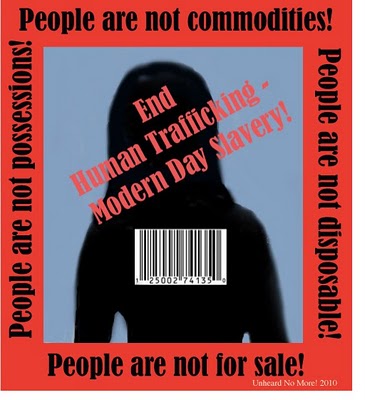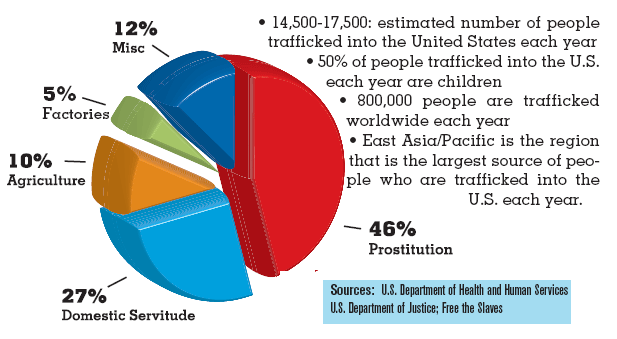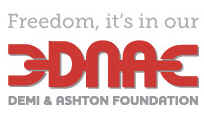|
Human
Trafficking

Trafficking in Persons is
the recruitment, transportation, transfer, harboring or receipt of
persons, by means of the threat or use of force or other forms of
coercion, of abduction, of fraud, of deception, of the abuse of power or
of a position of vulnerability or of the giving or receiving of payments
or benefits to achieve the consent of a person having control over another
person, for the purpose of exploitation. Exploitation shall include, at a
minimum, the exploitation of the prostitution of others or other forms of
sexual exploitation, forced labor or services, slavery or practices
similar to slavery, servitude or the removal of organs
There are an estimated 30
million slaves in the world today. More than at the height of the
Trans-Atlantic slave trade
 . .
Major forms of human
trafficking include:
Forced Labor
Recent studies show the
majority of human trafficking in the world takes the form of forced labor.
The ILO estimates that for every trafficking victim subjected to forced
prostitution, nine people are forced to work. Also known as involuntary
servitude, forced labor may result when unscrupulous employers exploit
workers made more vulnerable by high rates of unemployment, poverty,
crime, discrimination, corruption, political conflict, or cultural
acceptance of the practice. Immigrants are particularly vulnerable, but
individuals also may be forced into labor in their own countries. Female
victims of forced or bonded labor, especially women and girls in domestic
servitude, are often sexually exploited as well.
Sex Trafficking
Sex trafficking comprises a
smaller but still significant portion of overall human trafficking. When
an adult is coerced, forced, or deceived into prostitution – or maintained
in prostitution through coercion – that person is a victim of trafficking.
All of those involved in recruiting, transporting, harboring, receiving,
or obtaining the person for that purpose have committed a trafficking
crime. Sex trafficking can also occur within debt bondage, as women and
girls are forced to continue in prostitution through the use of unlawful
“debt” purportedly incurred through their transportation, recruitment, or
even their crude “sale” – which exploiters insist they must pay off before
they can be free. It is critical to understand that a person’s initial
consent to participate in prostitution is not legally determinative: if
they are thereafter held in service through psychological manipulation or
physical force, they are trafficking victims and should receive the
benefits outlined in the Palermo Protocol and applicable domestic laws.
Bonded Labor
One form of force or
coercion is the use of a bond, or debt. Often referred to as “bonded
labor” or “debt bondage,” the practice has long been prohibited under U.S.
law by its Spanish name – peonage – and the Palermo Protocol requires its
criminalization as a form of trafficking in persons. Workers around the
world fall victim to debt bondage when traffickers or recruiters
unlawfully exploit an initial debt the worker assumed as part of the terms
of employment. Workers may also inherit debt in more traditional systems
of bonded labor. In South Asia, for example, it is estimated that there
are millions of trafficking victims working to pay off their ancestors’
debts.
Debt Bondage Among Migrant
Laborers
Abuses of contracts and
hazardous conditions of employment for migrant laborers do not necessarily
constitute human trafficking. However, the attribution of illegal costs
and debts on these laborers in the source country, often with the support
of labor agencies and employers in the destination country, can contribute
to a situation of debt bondage. This is the case even when the worker’s
status in the country is tied to the employer as a guestworker in the
context of employment-based temporary work programs.
Involuntary Domestic
Servitude
A unique form of forced
labor is the involuntary servitude of domestic workers, whose workplace is
informal, connected to their off-duty living quarters, and not often
shared with other workers. Such an environment, which often socially
isolates domestic workers, is conducive to nonconsensual exploitation
since authorities cannot inspect private property as easily as they can
inspect formal workplaces. Investigators and service providers report many
cases of untreated illnesses and, tragically, widespread sexual abuse,
which in some cases may be symptoms of a situation of involuntary
servitude.
Forced Child Labor
Most international
organizations and national laws recognize children may legally engage in
certain forms of work. There is a growing consensus, however, that the
worst forms of child labor should be eradicated. The sale and trafficking
of children and their entrapment in bonded and forced labor are among
these worst forms of child labor, and these are forms of trafficking. A
child can be a victim of human trafficking regardless of the location of
that nonconsensual exploitation. Indicators of possible forced labor of a
child include situations in which the child appears to be in the custody
of a non-family member who has the child perform work that financially
benefits someone outside the child’s family and does not offer the child
the option of leaving. Anti-trafficking responses should supplement, not
replace, traditional actions against child labor, such as remediation and
education. However, when children are enslaved, their abusers should not
escape criminal punishment by virtue of longstanding administrative
responses to child labor practices.
Child Soldiers
Child soldiering can be a
manifestation of human trafficking where it involves the unlawful
recruitment or use of children – through force, fraud, or coercion – as
combatants or for labor or sexual exploitation by armed forces.
Perpetrators may be government forces, paramilitary organizations, or
rebel groups. Many children are forcibly abducted to be used as
combatants. Others are made unlawfully to work as porters, cooks, guards,
servants, messengers, or spies. Young girls can be forced to marry or have
sex with male combatants. Both male and female child soldiers are often
sexually abused and are at high risk of contracting sexually transmitted
diseases.
Child Sex Trafficking
According to UNICEF, as
many as two million children are subjected to prostitution in the global
commercial sex trade. International covenants and protocols obligate
criminalization of the commercial sexual exploitation of children. The use
of children in the commercial sex trade is prohibited under both U.S. law
and the Palermo Protocol as well as by legislation in countries around the
world. There can be no exceptions and no cultural or socioeconomic
rationalizations preventing the rescue of children from sexual servitude.
Sex trafficking has devastating consequences for minors, including
long-lasting physical and psychological trauma, disease (including HIV/
AIDS), drug addiction, unwanted pregnancy, malnutrition, social ostracism,
and possible death.
An estimated 2.5 million
people are in forced labor (including sexual exploitation) at any
given time as a result of trafficking
Of these:
- 1.4 million
– 56% - are in Asia and the Pacific
- 250,000
– 10% - are in Latin America and the Caribbean
- 230,000
– 9.2% - are in the Middle East and Northern Africa
- 130,000
– 5.2% - are in sub-Saharan countries
- 270,000
– 10.8% - are in industrialized countries
- 200,000
– 8% - are in countries in transition
• 161 countries are
reported to be affected by human trafficking by being a source, transit or
destination count
• People are reported to be
trafficked from 127 countries to be exploited in 137 countries,
affecting every continent and every type of economy
The Victims
-
The majority of
trafficking victims are between 18 and 24 years of age
-
An estimated 1.2
million children are trafficked each year
-
95% of victims
experienced physical or sexual violence during trafficking (based on
data from selected European countries)
-
43% of victims are
used for forced commercial sexual exploitation, of whom 98 per cent
are women and girls
-
32% of victims are
used for forced economic exploitation, of whom 56 per cent are women
and girls
-
52% of those
recruiting victims are men, 42% are women and 6% are both men and
women
-
In 54% of
cases the recruiter was a stranger to the victim, 46% of cases the
recruiter was known to victim
-
The
majority of suspects involved in the trafficking process are nationals
of the country where the trafficking process is occurring
The Profits
• Estimated global annual
profits made from the exploitation of all trafficked forced labour are
US$ 31.6 billion
Of this:
- US$ 15.5 billion –
49% - is generated in industrialized economies
- US$ 9.7 billion
– 30.6% is generated in Asia and the Pacific
- US$ 1.3 billion
– 4.1% is generated in Latin America and the Caribbean
- US$ 1.6 billion –
5% is generated in sub-Saharan Africa
- US$ 1.5 billion –
4.7% is generated in the Middle East and North Africa
You can report
trafficking crimes and get help by calling the Department of Justice Trafficking
in Persons and Worker Exploitation Task Force Complaint Line at 1-888-428-7581




Credit: U.S.
Department of State,UNODC
|

